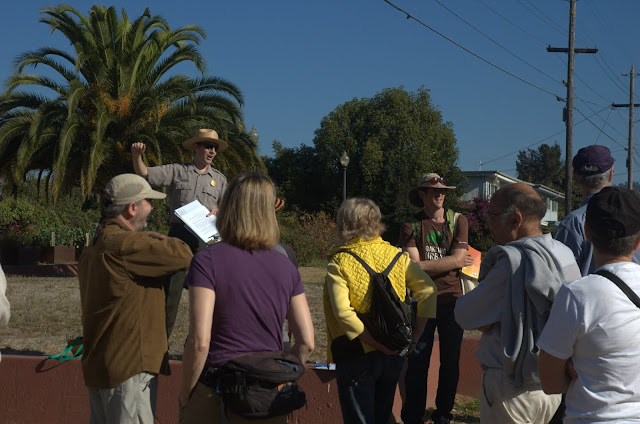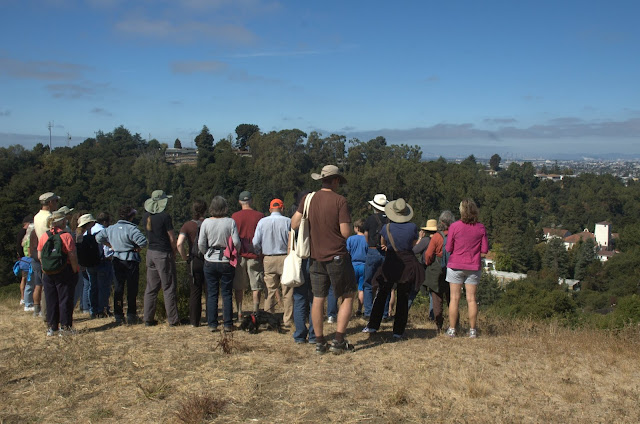On November 10th over 30 walkers and three dogs convened for the Oakland Urban Paths Rockridge Ramble. The 4-mile walk benefited from a post rain glow of sun and a hardy group of walkers well suited for the vigorous outing. The route covered 12 stair/pathway runs of varying styles and conditions and a pedestrian overcrossing. Walkers had a chance to appreciate pathways with and without wayfinding signs. Other memorable features of the walk included great views, a variety of street lamp styles, vacant lots (gap tooth reminders of the ’91 Berkeley Oakland Hills fire), and a diversity of post-fire architecture. All along the way, curious neighbors who asked what we are doing nodded and smiled knowingly when we told them we were checking out the stairs.
Check out our route below:
Rockridge Ramble at EveryTrail
The walk started at the recently refurbished Rockridge BART Plaza. To start we ducked underneath SR 24 and headed east along Miles. The route was designed to give the group an up close look at the underbelly of SR 24 and gain a further appreciation of the tranquility of the neighborhoods we would soon encounter.
Crossing over Boadway via pedestrian bridge, we were able to spy a small park between Brodway and the freeway with a marker for Byron Rumford. Mr. Rumford was a local politician and African American civic leader, and a member of the CA legislature from 1948-1966. Highway 24 is the Rumford Freeway named in his honor. You can learn more about him on the City of Oakland’s New Era, New Politics tour walking tour.
As the group climbed and plunged into the bends and folds of Rockridge, we were able to appreciate the retrofitted handrails at Brookside Lane.
At the top of Brookside Lane, the vegetation and housing are distinctly post-fire. When descending the lower run of Chaumont Path south of Buena Vista we had a chance to take a printed copy of poetry from the poetry steps, tended to by a caring neighbor. At the bottom of those same steps we met a long-time resident who told us about the day of the hills fire and how the winds blew in a favorable direction to spare his house.
The intersection of Romany and Golden Gate is interesting for a couple of reasons.
- While currently signed as Romany and Golden Gate, the sidewalk is stamped with two totally different street names.
- There are two very unique street lamp styles, in very close proximity. On this walk there were a total of three unique street lamp styles.
We wound along the pleasantly shady sidewalk of Romany and crossed the four-point intersection of Romany and Cross for our final bits of climbing. The Locarno Path is always fun to walk. It’s double-wide with balustrades and makes you feel grand as you get ready for the grand view on Alpine.
At the top of the Locarno Path on Apline, I was told by one of our walkers that we were indeed near the fabled Rockridge Rock. The exact location of said rock has been a topic of discussion on Andrew Alden’s blog.
We completed the ramble by descending the Margardio steps that were refurbished by the City of Oakland in 2010. On those stairs a couple of years ago, I had the chance to meet the owner of the adjacent house who apologized for contributing to the previous stairs demise. He told me that as a boy, his dad asked him to pull out a young tree growing near the stairs. He told his dad he had done this chore, but hadn’t and years later the mature tree would grow to uproot the stairs and landing.
Thanks to all our happy walkers, we’re looking forward to closing out this year’s walking tours with you next month on our Walk and Shop III.































